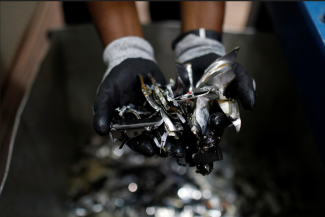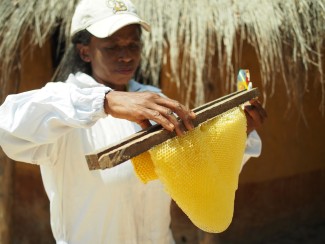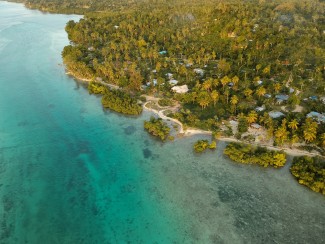As governments prepare for negotiations on a global treaty on plastic pollution, aid for trade can support LDC efforts to tackle this pollution crisis across the life cycle of plastics. Several pathways for cooperation can be pursued at the World Trade Organization.
Plastic pollution is a major threat to the environment, human health, and sustainable development. In March 2022, governments adopted a landmark resolution at the United Nations Environment Assembly (UNEA) to launch negotiations on a legally binding international instrument on plastic pollution. The ambition is to conclude a treaty by the end of 2024.
Importantly, the resolution addresses the full life cycle of plastics. In 2019, the value of international trade across the life cycle of plastics—from feedstocks and primary forms of plastics through to manufactured products and plastic waste—reached over US$1 trillion. This underlines the centrality of trade to the global plastics economy.
Recognizing the relevance of trade and trade policies to tackling plastic pollution, a growing group of World Trade Organization (WTO) members has joined an Informal Dialogue on Plastics Pollution and Environmentally Sustainable Plastics Trade (IDP) at the WTO. Established in 2020 to explore how trade-related cooperation at the WTO could support global efforts to reduce plastic pollution, the IDP now attracts participation from over 70 WTO members, including four least developed countries (LDCs) (Cambodia, Central African Republic, Chad, and The Gambia).
Plastic pollution in developing countries and LDCs
At the WTO, a striking feature of the IDP is the leadership role that a diverse group of developing countries have played in its formation, due in large part to the growing range of negative impacts of plastic pollution on their sustainable development. For LDCs, plastic pollution poses significant threats, including detrimental effects on key economic sectors and fiscal costs for governments faced with financing the prevention and management of plastic pollution.
While LDCs represent a small share of global trade in plastics (0.12% of the total volume of plastic exports and 0.96% of imports in 2020), the volumes of plastics crossing borders into these countries attract concern, especially given the limited capacity to manage plastic waste. As illustrated in the graph, LDCs are engaged in the import of goods across the life cycle of plastics. All LDCs import a far higher share of plastic products overall than they produce domestically or export
LDC imports and exports of plastics across the life cycle of plastics
A particular challenge in LDCs relates to the limited capacity to manage plastic waste. Some LDCs have sought to restrict or ban imports of specific single-use plastics that are deemed especially detrimental to national plastic pollution reduction efforts. For instance, Benin, Burkina Faso, Eritrea, Haiti, Senegal, and Vanuatu each impose different restrictions on the import, production, sale, and use of non-biodegradable plastic bags.
Despite such efforts, LDCs have to deal with millions of tonnes of plastic products imported each year, including products with embedded plastics and with associated plastic packaging.
Notably, while few LDCs are producers of plastics, some are active as producers and exporters at different points in plastic value chains (e.g. feedstocks used in plastic production or the manufacture of synthetic textiles) and have specific trade interests to consider. Bangladesh and Myanmar are among the top ten LDC importers of plastics, mainly for use by their textile industries.
Some LDCs also export products packaged in plastics as part of a value-addition strategy to meet market access standards (e.g. fruit and vegetable exports), protect products in transportation, or extend product life. As international standards and regulations evolve to tackle plastic pollution, LDC exports that participate in different aspects of the plastic value chain may face trade-related concerns and market access barriers that require attention.
Conversely, some LDCs may have opportunities in the production of effective non-plastic substitutes for imported plastics, including through the export of such non-plastic substitutes. Bangladesh, for instance, has a revealed comparative advantage in exports of natural fibres of jute and sisal that can be used as inputs into non-plastic end-use products as well as jute, cotton, and hemp grocery bags.
Pathways for cooperation on aid for trade at the WTO
The importance of cooperation with developing countries on plastic pollution, including through financial support and technical assistance and capacity building, is clearly emphasized in the UNEA resolution. Similarly, in a ministerial statement issued in December 2021, the co-sponsors of the IDP identify the importance of addressing the trade-related capacity building and technical assistance needs of least developed members in regard to plastic pollution, and call for consideration of aid for trade options.
Aid for trade is an essential component of the financing landscape for LDCs to harness trade and trade policies for their sustainable development. It is also a vehicle that LDCs can use to support the transition to more sustainable trade while building resilience to environmental challenges and advancing economic diversification.
The IDP work plan for 2022 provides WTO members with an opportunity to consider options for meaningful “deliverables” on aid for trade that could support LDCs to tackle plastic pollution in ways that are aligned with their sustainable development priorities. There are several pathways for cooperation through aid for trade that can be harnessed.
An initial step would be for WTO members participating in the IDP to mainstream attention to the aid for trade needs of developing countries, including LDCs, in each of the initiative’s three work streams. The flow chart proposes a process through which LDCs could advance their aid for trade priorities and sustainability objectives through the IDP.
Process for advancing cooperation on aid for trade priorities in the IDP

Note: The examples of sustainability objectives and of aid for trade actors and initiatives relevant to plastic pollution are not exhaustive. AfT refers to aid for trade and ODA to official development assistance.
Options for concrete outcomes for LDCs on aid for trade and plastic pollution
Several options are available for WTO members to deliver concrete outcomes for LDCs on aid for trade and plastic pollution.
In the short term, IDP co-sponsors could recommend the integration of LDC priorities on plastic pollution in the next work programme of the WTO-led Aid for Trade Initiative as well as the work of the Enhanced Integrated Framework.
LDCs could also call for the launch of specific WTO training and technical assistance initiatives around the design and implementation of trade-related policies and regulatory frameworks required for reducing plastic pollution and promoting non-toxic circularity in the plastic sector. This assistance would ideally be implemented in collaboration with other relevant actors like the United Nations Environment Programme, the Basel Convention Secretariat, and the World Customs Organization.
In the medium term, options could include calling for enhanced support for the implementation of the Basel Convention plastic waste amendments and trade-related activities in the Plastic Waste Partnership agenda. In parallel, LDCs could consider how to ensure attention is given to trade-related assistance as part of the package of financial and technical assistance expected to be integrated into the future treaty on plastic pollution.
LDCs could also put forward specific requests for aid for trade, such as support for compliance of LDC firms with the growing array of standards and technical regulations related to plastics and plastic pollution. Aid for trade could also enable LDCs to access environmentally sound waste management goods, services, and technologies and support economic diversification, for example by enhancing manufacturing and trade capacities for non-plastic substitutes.
Beyond aid for trade, a broader package of green economy-related financing and development assistance will be necessary to address the plastic pollution crisis in LDCs and to facilitate a just transition towards more circular economies in LDCs.
Conclusion
As WTO members work through the IDP to bolster cooperation on trade and trade policies to complement and support global efforts to end plastic pollution, strengthened aid for trade on plastic pollution will be vital.
By conveying their aid for trade priorities through the IDP, as well as through the WTO Committee on Trade and Environment and the Committee on Trade and Development, LDCs have an opportunity to attract the support needed to address trade-related challenges and opportunities arising from global efforts to tackle plastic pollution.
Photo by Naja Bertolt Jensen on Unsplash
If you would like to reuse any material published here, please let us know by sending an email to EIF Communications: eifcommunications@wto.org.




